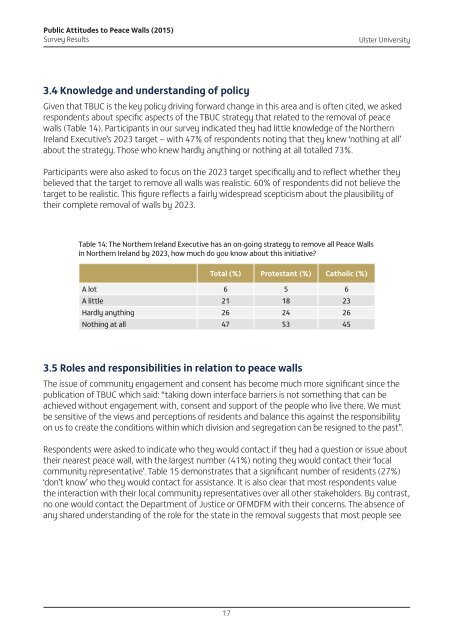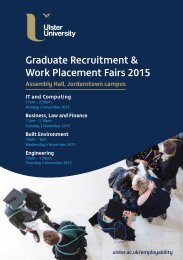Public Attitudes to Peace Walls (2015)
1RRkqqy
1RRkqqy
Create successful ePaper yourself
Turn your PDF publications into a flip-book with our unique Google optimized e-Paper software.
<strong>Public</strong> <strong>Attitudes</strong> <strong>to</strong> <strong>Peace</strong> <strong>Walls</strong> (<strong>2015</strong>)<br />
Survey Results<br />
Ulster University<br />
3.4 Knowledge and understanding of policy<br />
Given that TBUC is the key policy driving forward change in this area and is often cited, we asked<br />
respondents about specific aspects of the TBUC strategy that related <strong>to</strong> the removal of peace<br />
walls (Table 14). Participants in our survey indicated they had little knowledge of the Northern<br />
Ireland Executive’s 2023 target – with 47% of respondents noting that they knew ‘nothing at all’<br />
about the strategy. Those who knew hardly anything or nothing at all <strong>to</strong>talled 73%.<br />
Participants were also asked <strong>to</strong> focus on the 2023 target specifically and <strong>to</strong> reflect whether they<br />
believed that the target <strong>to</strong> remove all walls was realistic. 60% of respondents did not believe the<br />
target <strong>to</strong> be realistic. This figure reflects a fairly widespread scepticism about the plausibility of<br />
their complete removal of walls by 2023.<br />
Table 14: The Northern Ireland Executive has an on-going strategy <strong>to</strong> remove all <strong>Peace</strong> <strong>Walls</strong><br />
in Northern Ireland by 2023, how much do you know about this initiative?<br />
Total (%) Protestant (%) Catholic (%)<br />
A lot 6 5 6<br />
A little 21 18 23<br />
Hardly anything 26 24 26<br />
Nothing at all 47 53 45<br />
3.5 Roles and responsibilities in relation <strong>to</strong> peace walls<br />
The issue of community engagement and consent has become much more significant since the<br />
publication of TBUC which said: “taking down interface barriers is not something that can be<br />
achieved without engagement with, consent and support of the people who live there. We must<br />
be sensitive of the views and perceptions of residents and balance this against the responsibility<br />
on us <strong>to</strong> create the conditions within which division and segregation can be resigned <strong>to</strong> the past”.<br />
Respondents were asked <strong>to</strong> indicate who they would contact if they had a question or issue about<br />
their nearest peace wall, with the largest number (41%) noting they would contact their ‘local<br />
community representative’. Table 15 demonstrates that a significant number of residents (27%)<br />
‘don’t know’ who they would contact for assistance. It is also clear that most respondents value<br />
the interaction with their local community representatives over all other stakeholders. By contrast,<br />
no one would contact the Department of Justice or OFMDFM with their concerns. The absence of<br />
any shared understanding of the role for the state in the removal suggests that most people see<br />
17




